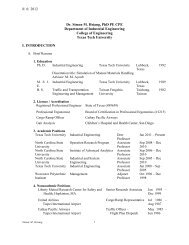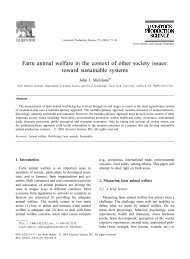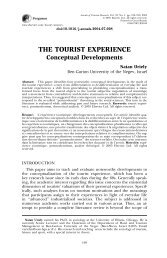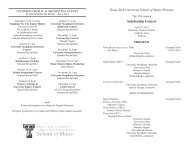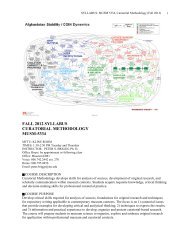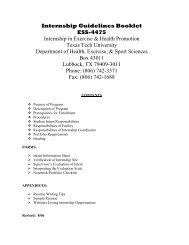Tourism: a Sacred Journey? The Case of Ashram Tourism, India
Tourism: a Sacred Journey? The Case of Ashram Tourism, India
Tourism: a Sacred Journey? The Case of Ashram Tourism, India
You also want an ePaper? Increase the reach of your titles
YUMPU automatically turns print PDFs into web optimized ePapers that Google loves.
INTERNATIONAL JOURNAL OF TOURISM RESEARCH<br />
Int. J. <strong>Tourism</strong> Res. 7, 161–171 (2005)<br />
Published online in Wiley InterScience (www.interscience.wiley.com). DOI: 10.1002/jtr.522<br />
<strong>Tourism</strong>: a <strong>Sacred</strong> <strong>Journey</strong>? <strong>The</strong> <strong>Case</strong> <strong>of</strong><br />
<strong>Ashram</strong> <strong>Tourism</strong>, <strong>India</strong><br />
Richard Sharpley* and Priya Sundaram<br />
University <strong>of</strong> Hull, Scarborough Campus, Filey Road, Scarborough YO11 3AZ, UK<br />
ABSTRACT<br />
Religious tourism — tourism that is<br />
motivated by faith or religious reasons —<br />
has been in evidence for centuries. In more<br />
recent times, however, it has been suggested<br />
that modern tourism has become the<br />
functional and symbolic equivalent <strong>of</strong> more<br />
traditional religious practices, such as<br />
festivals and pilgrimages. In other words, it<br />
is claimed by some that tourism is a sacred<br />
journey. To date, however, little work has<br />
been undertaken to explore this position;<br />
the purpose <strong>of</strong> this paper, therefore, is to<br />
contribute to this debate. Based on an<br />
exploratory study, it considers the<br />
motivations and experiences <strong>of</strong> Western<br />
tourists visiting the Sri Aurobindo <strong>Ashram</strong><br />
and the nearby utopian township <strong>of</strong><br />
Auroville in Pondicherry, south east <strong>India</strong>.<br />
It identifies two principal groups <strong>of</strong> visitors,<br />
namely ‘permanent tourists’ who have<br />
immersed themselves indefinitely in a<br />
spiritual ‘Other’, and temporary visitors.<br />
<strong>The</strong> latter are categorised into sub-groups<br />
which point to a variety <strong>of</strong> spiritual and<br />
non-spiritual motives. <strong>The</strong> paper concludes<br />
that there is a continuum <strong>of</strong> spirituality<br />
inherent in tourism, though this is related to<br />
tourists’ experience rather than initial<br />
motivation. Copyright © 2005 John Wiley &<br />
Sons, Ltd.<br />
Received 12 October 2004; Accepted 3 January 2005<br />
*Correspondence to: Richard Sharpley, University <strong>of</strong> Hull,<br />
Scarborough Campus, Filey Road, Scarborough, North<br />
Yorkshire YO11 3AZ, UK.<br />
E-mail: R.Sharpley@hull.ac.uk<br />
Keywords: religious tourism; tourism as<br />
religion; pilgrimage; ashram tourism.<br />
Anyone seeking answers to questions <strong>of</strong><br />
life or other personal issues which trouble<br />
one’s self can do so in <strong>India</strong> ...<strong>The</strong> quest<br />
for discovering one’s own God ends, and<br />
the journey towards the realisation <strong>of</strong> the<br />
self begins with a visit to timeless, spiritual<br />
<strong>India</strong>. (www.bestindianhotels.com<br />
2003).<br />
INTRODUCTION<br />
It has long been recognised that a variable<br />
relationship exists between the institutions<br />
<strong>of</strong> religion and tourism. On the one hand,<br />
religious tourism may be identified as a specific<br />
type <strong>of</strong> tourism ‘whose participants are<br />
motivated either in part or exclusively for religious<br />
reasons’ (Rinschede, 1992). Probably one<br />
<strong>of</strong> the oldest forms <strong>of</strong> tourism, with human<br />
migration being linked to religion from earliest<br />
times (Sigaux, 1966; Vukonić, 1996), this is<br />
manifested in a diversity <strong>of</strong> touristic-religious<br />
activity, from long-term journeys (i.e. pilgrimage)<br />
to and/or stays at religious centres to<br />
short-term visits to religious centres or sites for<br />
the purpose <strong>of</strong> religious celebration, contemplation<br />
or meeting. In the former case, the<br />
entire trip may be religious in purpose,<br />
whereas in the latter, visits to religious sites<br />
may be but one element <strong>of</strong> a multifunctional<br />
trip.<br />
On the other hand, tourism may be considered<br />
as religion. In other words, in modern,<br />
secular societies, not only has free (i.e. discretionary<br />
or non-work) time in general become<br />
‘a space for the contemplative and the creative,<br />
a unity <strong>of</strong> thought and action’ (Vukonić, 1996,<br />
p. 8), an opportunity for human beings to<br />
Copyright © 2005 John Wiley & Sons, Ltd.
162 R. Sharpley and P. Sundaram<br />
recognise and cultivate their spiritual needs,<br />
but also tourism, as a particular use <strong>of</strong> such<br />
free time, has come to be seen by some as a<br />
spiritual or sacred journey. As Graburn (1989,<br />
p. 22) observes, ‘tourism . . . is functionally and<br />
symbolically equivalent to other institutions<br />
that humans use to embellish and add<br />
meaning to their lives’; it may be understood<br />
either as a regular secular ritual (the annual<br />
vacation) that acts as a counterpoint to everyday<br />
life and work or as a more specific rite <strong>of</strong><br />
passage or ‘personal transition’ (Nash, 1996)<br />
undertaken at particular junctions in peoples’<br />
lives. In either case, however, it can be argued<br />
that tourism is ‘the modern equivalent . . . <strong>of</strong><br />
festivals and pilgrimages found in more traditional,<br />
God-fearing societies’ (Graburn, 2001,<br />
p. 43; see also Graburn, 1983).<br />
Thus, the varying relationship between<br />
tourism and religion may be conceptualised as<br />
a continuum based upon the degree <strong>of</strong> intensity<br />
<strong>of</strong> religious motivation inherent in what<br />
Smith (1992a) refers to as the ‘quest in guest’.<br />
At one extreme lies sacred pilgrimage, a<br />
journey driven by faith, religion and spiritual<br />
fulfilment; at the other extreme lies the secular<br />
tourist who may seek to satisfy some personal<br />
or spiritual need through tourism. Between<br />
these two points can be found different<br />
forms/intensities <strong>of</strong> religious tourism motivated<br />
to a greater or lesser extent by religious<br />
or, conversely, cultural or knowledge-based<br />
needs. As Smith (1992a) puts it, some religious<br />
tourists may be ‘more pilgrim than tourist’,<br />
whereas others may be ‘more tourist than<br />
pilgrim’.<br />
However, despite this recognition <strong>of</strong> the link<br />
between tourism and religion, particularly in a<br />
historical context, relatively little attention has<br />
been paid to the subject within the tourism literature.<br />
More specifically, although the existence<br />
<strong>of</strong> what Vukonić (1996) refers to as ‘homo<br />
turisticus religiosus’, or the religious tourist, is<br />
widely accepted and discussed to some extent<br />
in the literature in the context <strong>of</strong> both consumption<br />
(Vukonić, 1996; see also Smith,<br />
1992b; Franklin, 2003) and supply (Shackley,<br />
2001), few if any attempts have been made to<br />
explore the cultural meaning <strong>of</strong> tourism as a<br />
modern spiritual experience. That is, although<br />
it has been argued by some that contemporary<br />
tourism, as a phenomenon <strong>of</strong> modern, secular<br />
societies, fulfils some spiritual need within<br />
tourists, there exists little evidence to support<br />
this claim. <strong>The</strong> purpose <strong>of</strong> this paper, therefore,<br />
is to begin to address this gap in the literature.<br />
Focusing on tourism to <strong>India</strong>, a destination<br />
that, since the 1960s, has come to epitomise the<br />
spiritual touristic experience (Mehta, 1990;<br />
Brown, 1998; Sutcliffe, 1998), it considers the<br />
outcomes <strong>of</strong> an exploratory study into the<br />
motivations <strong>of</strong> Western visitors to a specific<br />
religious site, the Sri Aurobindo <strong>Ashram</strong> in the<br />
southeast <strong>of</strong> the country. In so doing, it challenges<br />
some <strong>of</strong> the assumptions regarding the<br />
spiritual nature <strong>of</strong> the modern tourist experience,<br />
while highlighting the need for greater<br />
knowledge and understanding <strong>of</strong> the subject.<br />
<strong>The</strong> first task, however, is to review briefly the<br />
theoretical debate surrounding the concept <strong>of</strong><br />
tourism as a sacred journey or spiritual experience<br />
as a framework for the subsequent<br />
discussion.<br />
TOURISM: A SACRED JOURNEY?<br />
Spirituality, according to Brown (1998, p. 1),<br />
‘has become a kind <strong>of</strong> buzz-word <strong>of</strong> the age<br />
. . . an all-purpose word, but one that describes<br />
what is felt to be missing rather than specifying<br />
what is hoped to be found . . . <strong>The</strong> spiritual<br />
search ...has become a dominant feature <strong>of</strong><br />
late twentieth-century life: a symptom <strong>of</strong> collective<br />
uncertainty’. Similarly, but in the specific<br />
context <strong>of</strong> tourism, MacCannell (1973)<br />
suggests that, as a response to the perceived<br />
inauthenticity <strong>of</strong> modern societies, tourists<br />
have become secular pilgrims searching for the<br />
authentic: ‘sightseeing is a kind <strong>of</strong> collective<br />
striving for a transcedence <strong>of</strong> the modern totality,<br />
a way <strong>of</strong> attempting to overcome the discontinuity<br />
<strong>of</strong> modernity (MacCannell, 1989, p.<br />
13). In other words, the alleged anomic condition<br />
<strong>of</strong> modern societies has resulted in a<br />
search for spiritual meaning and, as a modern<br />
form <strong>of</strong> mass migration, tourism is seen as a<br />
popular and particularly effective vehicle for<br />
undertaking that search. As a consequence, it<br />
is suggested by some that tourism is a modernday<br />
sacred journey, the contemporary and<br />
functional equivalent <strong>of</strong> the traditional<br />
pilgrimage.<br />
According to Smith (1992a), tourism and pilgrimage<br />
are superficially similar in that both<br />
Copyright © 2005 John Wiley & Sons, Ltd. Int. J. <strong>Tourism</strong> Res. 7, 161–171 (2005)
<strong>Tourism</strong>: a sacred journey? 163<br />
tourists and pilgrims share the same fundamental<br />
requirements to undertake their<br />
journey, namely, free (leisure) time, sufficient<br />
financial resources and social sanction — in<br />
the latter case, social ‘approval’ is a powerful<br />
force in determining the appropriate use <strong>of</strong><br />
free time. At the same time, observed tourist<br />
behaviour is analogous to a form <strong>of</strong> pilgrimage;<br />
that is, many tourist sights or attractions<br />
are accorded the status <strong>of</strong> a religious icon or<br />
symbol. As Urry (1990, p. 12) observes, they<br />
have to be seen or gazed upon; they are<br />
‘famous for being famous ...[and] ...entail a<br />
kind <strong>of</strong> pilgrimage to a sacred centre, which is<br />
<strong>of</strong>ten a capital or major city’. However, a distinction<br />
between tourism and pilgrimage may<br />
be identified within the meaning or personal<br />
belief attached to each activity. That is, pilgrimage<br />
may be considered the purposeful,<br />
serious, legitimate or pious pursuit <strong>of</strong> spiritual<br />
fulfilment, whereas tourism, by comparison,<br />
may be described as the search for hedonistic,<br />
frivolous and superficial wish-fulfilment<br />
(Pfaffenberger, 1983). Nevertheless, if these<br />
labels are stripped away, it becomes apparent<br />
that the individual experience <strong>of</strong> tourism and<br />
pilgrimage may not be so distinct. As Pfaffenberger<br />
(1983) argues, ‘the difference between<br />
tourism and pilgrimage lies not so much in any<br />
radical phenomenological difference between<br />
them . . . but rather in the culturally-supplied<br />
language <strong>of</strong> symbols in which travellers are<br />
obliged to express the peregrinations.’<br />
A number <strong>of</strong> commentators have linked the<br />
notion <strong>of</strong> tourism as a spiritual or sacred<br />
journey with Turners’ widely cited work on<br />
ritual processes, including pilgrimage (Turner<br />
and Turner, 1978). According to them, participation<br />
in transitional rituals or pilgrimage<br />
involves a three-stage process. Initially, people<br />
go through the separation stage, where they<br />
become freed or distanced from the ordinary,<br />
routine or ‘pr<strong>of</strong>ane’ (Graburn, 1989). This is<br />
followed by the phase <strong>of</strong> ‘liminality’, or entry<br />
into a ‘sacred’ state <strong>of</strong> anti-structure in which<br />
the structure and order <strong>of</strong> normal life dissolve,<br />
everyday obligations cease to exist and new<br />
forms <strong>of</strong> relationships are created based upon<br />
a levelling <strong>of</strong> statuses. This condition, referred<br />
to as ‘communitas’ by Turner and Turner<br />
(1978), ‘produces a special feeling <strong>of</strong> excitement<br />
and close bonding between participants’<br />
(Graburn, 2001, p. 47); the structured behaviour<br />
<strong>of</strong> everyday life is replaced by liberated<br />
and spontaneous activities that may not be<br />
socially sanctioned within the normal, home<br />
environment. For tourists, liminality is experienced<br />
in places ‘on the margin’ (Shields, 1990)<br />
and may be expressed in a variety <strong>of</strong> ways<br />
(Lett, 1983; Passariello, 1983). Finally, <strong>of</strong><br />
course, people must progress through the<br />
process <strong>of</strong> re-integration as they return to the<br />
structured, everyday existence <strong>of</strong> their home<br />
society — importantly, for those having experienced<br />
some form <strong>of</strong> transitional ritual, this<br />
reintegration is frequently at a changed or<br />
higher status.<br />
<strong>The</strong>re are evident links between tourism and<br />
pilgrimage in terms <strong>of</strong> both the journey and the<br />
experience <strong>of</strong> communitas; indeed, Turner and<br />
Turner famously claim that ‘a tourist is half a<br />
pilgrim, if a pilgrim is half a tourist’ (1978,<br />
p. 20), although they distinguish between the<br />
obligatory nature <strong>of</strong> many traditional rituals<br />
and the voluntary nature <strong>of</strong> tourism. Equally,<br />
there is little doubt that some ‘tourist encounters<br />
can be just as compelling [as pilgrimage]<br />
and almost spiritual in personal meaning’<br />
(Smith, 1992a). Nevertheless, just as few would<br />
accept Boorstin’s (1964) position that the<br />
modern tourist is satisfied with pseudo-events,<br />
so too would few agree with MacCannell’s<br />
(1989) assertion that all tourists are modern pilgrims<br />
on an (albeit doomed) search for authenticity.<br />
That is, tourists seek to satisfy an<br />
enormous variety <strong>of</strong> personal or spiritual<br />
needs and, therefore, to classify all tourism as<br />
a response to modernity’s collective uncertainties<br />
and, hence, a search for spiritual reward<br />
may be misleading. Indeed, it is unlikely that<br />
all tourists sense anomie to the same degree.<br />
Thus, Cohen’s (1979) ‘existential tourist’ may<br />
seek the ‘centre out there’ and, hence, undertake<br />
an individual ‘pilgrimage’ in search <strong>of</strong><br />
spiritual fulfilment whereas ‘recreational<br />
tourists’ may, by definition, seek simply to<br />
relax and re-create.<br />
Moreover, the relationship between the<br />
journey and spiritual experiences remains<br />
fuzzy; for example, visits to ‘worship’ at the<br />
homes or graves <strong>of</strong> deceased celebrities, <strong>of</strong>ten<br />
referred to as ‘dark tourism’ (Lennon and<br />
Foley, 2000; Sharpley, 2003), is akin to traditional<br />
pilgrimage whereas many who walk the<br />
Copyright © 2005 John Wiley & Sons, Ltd. Int. J. <strong>Tourism</strong> Res. 7, 161–171 (2005)
164 R. Sharpley and P. Sundaram<br />
Santiago de Compostella pilgrimage route<br />
may do so only for the physical challenge<br />
(although this in itself may be interpreted as<br />
providing contemporary spiritual reward).<br />
Equally, momentary experiences within otherwise<br />
mundane journeys may be spiritually<br />
uplifting. As de Botton (2003) notes, the link<br />
between sublimity and religion has long been<br />
explicit; ‘it is no coincidence that the Western<br />
attraction to sublime landscapes developed at<br />
precisely the moment when traditional beliefs<br />
in God began to wane’ (de Botton, 2003, p. 171)<br />
Thus, momentary gazing upon particular<br />
landscapes or views may satisfy the individual’s<br />
need for spiritual refreshment.<br />
To summarise this section, then, tourism and<br />
pilgrimage share many features — the requirements<br />
<strong>of</strong> free time, social sanction and income,<br />
as well as the process <strong>of</strong> transfer from ordinary/pr<strong>of</strong>ane<br />
to non-ordinary/sacred time<br />
and place. It is, therefore, possible to refer to<br />
tourism generically as a sacred journey, particularly<br />
as vacations may have significant personal<br />
meaning. Nevertheless, distinctions<br />
remain in the context <strong>of</strong> quest, between the<br />
‘true’ pilgrim following his or her faith and the<br />
secular pilgrim seeking meaning or knowledge.<br />
Thus, as Smith (1992a) suggests, pilgrimage<br />
and tourism may be conceptualised as<br />
‘two parallel, interchangeable lanes’ following<br />
different quests — the religious and the<br />
secular. Tourists may travel either lane or<br />
‘switch between them, depending on personal<br />
need or motivation’ (Smith, 1992a). However,<br />
as this paper now goes on to consider, even<br />
within destinational contexts where this lane<br />
switch may logically be assumed to occur (i.e.<br />
where tourism becomes primarily a spiritual<br />
journey), questions still remain over the nature<br />
<strong>of</strong> the individual quest and, hence, the<br />
meaning <strong>of</strong> the journey.<br />
THE STUDY — ‘ASHRAM TOURISM’<br />
IN INDIA<br />
Given the lack <strong>of</strong> research into, or evidence to<br />
support, the concept <strong>of</strong> tourism as a sacred<br />
journey, the purpose <strong>of</strong> this study is to begin<br />
to address the gap in the literature by<br />
exploring the motivations <strong>of</strong> Western<br />
tourists in southern <strong>India</strong>. More specifically,<br />
it seeks to reveal the quest in Western visitors<br />
to the Sri Aurobindo <strong>Ashram</strong> and the associated<br />
town <strong>of</strong> Auroville, located near<br />
Pondicherry in southeast <strong>India</strong>. This site was<br />
selected as it is, for Western visitors, one <strong>of</strong> the<br />
most popular and well-known ashrams in the<br />
country. More generally, however, it is also an<br />
important religious site within a country that,<br />
arguably, epitomises spiritual touristic<br />
experiences.<br />
<strong>The</strong> context: <strong>India</strong> as a spiritual destination<br />
<strong>Tourism</strong>, particularly religious tourism, has a<br />
long history in <strong>India</strong>; ‘if travel and tourism are<br />
ways <strong>of</strong> enlightening the spirit ...they have<br />
been practised for centuries in <strong>India</strong>, whose<br />
peoples have long expressed a common sense<br />
<strong>of</strong> community in organized religion’ (Singh,<br />
2001, p. 138). Indeed, the practice <strong>of</strong> tirthayatra,<br />
or pilgrimage, has been an element <strong>of</strong> <strong>India</strong>n<br />
social life since ancient times (Kamra, 1997;<br />
Gupta et al., 2002) and nowadays remains the<br />
mainstay <strong>of</strong> the domestic tourism industry —<br />
it is estimated that almost 95% <strong>of</strong> domestic<br />
travellers are religious tourists, and, overall,<br />
some 144 million domestic tourist trips were<br />
made in 1998 (Singh, 2001).<br />
In contrast, international tourism to <strong>India</strong><br />
remains, in terms <strong>of</strong> volume, relatively<br />
insignificant. Modern tourism to the subcontinent<br />
dates back to the nineteenth century, primarily<br />
based on the colonial relationship with<br />
Britain (the British were also instrumental in<br />
developing hill stations, such as Simla, as<br />
retreats from the summer heat) and, by 1880,<br />
Thomas Cook enjoyed a virtual monopoly on<br />
all international tourism to the country.<br />
However, it was not until the mid-1940s that<br />
the colonial government began to recognise<br />
the economic potential <strong>of</strong> tourism and, in 1948,<br />
the newly independent government established<br />
the first body to promote tourism. Since<br />
then, and despite political upheavals, sporadic<br />
terrorist activity and health scares, international<br />
tourism has grown, albeit slowly. In<br />
1951, just 17000 international arrivals were<br />
recorded; by 2000, total arrivals had reached<br />
almost 2.65 million (Mintel, 2003). Of these,<br />
20% were from neighbouring Pakistan and<br />
Bangladesh, but Europe remains the biggest<br />
market, accounting for around 34% <strong>of</strong> all international<br />
arrivals. Not surprisingly, Britain pro-<br />
Copyright © 2005 John Wiley & Sons, Ltd. Int. J. <strong>Tourism</strong> Res. 7, 161–171 (2005)
<strong>Tourism</strong>: a sacred journey? 165<br />
vides the largest proportion <strong>of</strong> European<br />
arrivals and almost 40% <strong>of</strong> these are travellers<br />
visiting friends and relatives (VFR). Thus,<br />
<strong>India</strong>’s share <strong>of</strong> global tourist arrivals is, at just<br />
0.4%, insignificant although, reflecting the<br />
dominance <strong>of</strong> VFR tourists, average length <strong>of</strong><br />
stay is over 30 days.<br />
<strong>The</strong> relative weakness <strong>of</strong> <strong>India</strong>’s international<br />
tourism sector is, perhaps, surprising<br />
given the diverse attractions <strong>of</strong> the county,<br />
although most commentators point to haphazard<br />
tourism development policies and poor<br />
infrastructure as significant barriers. Nevertheless,<br />
since the 1960s, the country has<br />
become popular amongst Western visitors<br />
seeking some form <strong>of</strong> spiritual experience. Initially<br />
manifested in the ‘great overland movement<br />
from Europe . . . through Iran and<br />
Afghanistan . . . probably motivated by a<br />
search for “meaning” . . . from the Eastern<br />
gurus’ (Smith, 1992a), <strong>India</strong>’s reputation as a<br />
spiritual destination received a significant<br />
boost from visits by celebrities:<br />
Now it was the turn <strong>of</strong> the populists, the<br />
Beatles and the Rolling Stones to become<br />
the pacemakers for a faltering Western<br />
heart, and they achieved a more striking<br />
success ...<strong>The</strong> first wave <strong>of</strong> disciples was<br />
really top drawer. <strong>The</strong>y were the nobles<br />
<strong>of</strong> the meritocracy and they were looking<br />
good. <strong>The</strong> women were models, the men<br />
were stars, and the massage was the<br />
message. When they came out <strong>of</strong> their<br />
spiritual retreats draped in homespun,<br />
they glowed with vegetarian good health<br />
( Mehta, 1990, p. 68).<br />
By the early 1980s, political upheaval in Iran<br />
and Afghanistan had signalled the demise <strong>of</strong><br />
the overland trail but there is no doubt that<br />
<strong>India</strong> continues to attract large numbers <strong>of</strong><br />
Western travellers seeking to experience spiritual<br />
<strong>India</strong>; indeed, there now exists a number<br />
<strong>of</strong> specialist tour operators to meet the needs<br />
<strong>of</strong> those seeking such an experience. For<br />
example, Sprit <strong>of</strong> <strong>India</strong> (see www.spirit-<strong>of</strong>india.com)<br />
<strong>of</strong>fers ‘Yoga <strong>Journey</strong>s’ and a variety<br />
<strong>of</strong> pilgrimages to religious ceremonies and festivals,<br />
including the Kumbha Mela, the most<br />
important <strong>of</strong> all Hindu spiritual festivals that<br />
occurs every three years and, most famously,<br />
once every twelve years in the city <strong>of</strong><br />
Allahabad.<br />
Of course, it is not only festivals that attract<br />
Western visitors — <strong>India</strong> <strong>of</strong>fers a kaleidoscope<br />
<strong>of</strong> different religions and religious practices,<br />
evidenced in an enormous variety <strong>of</strong> shrines,<br />
temples and icons, and contemporary life in<br />
the country is manifestly spiritual: ‘you learn<br />
that, over there, the everyday person is the true<br />
holyman’ (Weis, 2003). Nevertheless, specific<br />
religious sites have long attracted western visitors;<br />
these include Dharamsala (a former<br />
British hill station to which the Dalai Lama fled<br />
from Tibet, and now a centre for the study <strong>of</strong><br />
Tibetan culture) and Rishikesh, the town<br />
where the Beatles visited their guru in the<br />
1960s and now a place to study Hinduism.<br />
More generally, ashrams have also proved to<br />
be a magnet for Western visitors (for many, an<br />
essential element <strong>of</strong> a visit to <strong>India</strong> — see<br />
Sutcliffe (1998)). Perhaps the most famous <strong>of</strong><br />
these is the home <strong>of</strong> the controversial Sai Baba<br />
in Puttaparthi, although the Sri Aurobindo<br />
<strong>Ashram</strong>, the focus for this study, is also a<br />
popular destination.<br />
<strong>The</strong> case study: Sri Aurobindo <strong>Ashram</strong><br />
<strong>The</strong> term ‘ashram’ is derived from the Sanskrit<br />
word srama, meaning religious exercise,<br />
although it is now used generically to describe<br />
a spiritual retreat or college, usually established<br />
by a Hindu sage or ‘guru’ (a teacher or<br />
holy man). <strong>The</strong>re are innumerable ashrams in<br />
<strong>India</strong> (and elsewehere) ranging from the<br />
homes <strong>of</strong> gurus to large, purpose built establishments<br />
with resident populations <strong>of</strong><br />
disciples.<br />
<strong>The</strong> Sri Aurobindo <strong>Ashram</strong> in Pondicherry,<br />
a former French colony in the south-eastern<br />
state <strong>of</strong> Tamil Nadu, is unique inasmuch as it<br />
is directly associated with the founding and<br />
development <strong>of</strong> a nearby township, Auroville,<br />
the purpose <strong>of</strong> which is to realise the ideal <strong>of</strong><br />
human unity. <strong>The</strong> <strong>Ashram</strong> itself was founded<br />
by Sri Aurobindo, who was born in Calcutta in<br />
1872. Educated at school and university<br />
in England, he returned to Baroda in <strong>India</strong> in<br />
1893 and worked in the local civil service<br />
before becoming a pr<strong>of</strong>essor at Baroda College.<br />
Over a 13 year period he began to practice<br />
yoga as well as becoming involved in politics<br />
Copyright © 2005 John Wiley & Sons, Ltd. Int. J. <strong>Tourism</strong> Res. 7, 161–171 (2005)
166 R. Sharpley and P. Sundaram<br />
Figure 1. <strong>The</strong> Matrimandir, Auroville.<br />
before moving back to Calcutta in 1913. His<br />
political activities led to him being detained for<br />
a year before he travelled to Pondicherry in<br />
1910, where he devoted the next 40 years <strong>of</strong> his<br />
life to spiritual development through the practice<br />
<strong>of</strong> yoga. In 1920, he commenced a collaboration<br />
with the French-born Mirra Alfassa<br />
who, on first meeting Sri Aurobindo in 1914,<br />
had recognised him as the ‘master who had<br />
inwardly been guiding her spiritual development’<br />
(Sri Aurobindo <strong>Ashram</strong>, 2001). Later to<br />
become known simply as the ‘Mother’, she<br />
took charge <strong>of</strong> his disciples and formally established<br />
the <strong>Ashram</strong> when, in 1926, Sri<br />
Aurobindo went into seclusion. Since then, the<br />
<strong>Ashram</strong> has grown from a small community <strong>of</strong><br />
some two dozen disciples to a large, diverse<br />
community <strong>of</strong> over 1200 people. <strong>The</strong> focus <strong>of</strong><br />
community life is the <strong>Ashram</strong>, an interconnecting<br />
block <strong>of</strong> houses including those in<br />
which Sri Aurobindo and the Mother lived for<br />
most <strong>of</strong> their lives — their remains lie in the<br />
samadhi, or grave, in the central courtyard.<br />
However, ashramites live and work throughout<br />
the area, and within the ashram they are<br />
free to follow their sadhana, or spiritual discipline,<br />
to suit their individual needs. That is,<br />
there are no obligatory practices, rituals or<br />
compulsory meditations within the ashram<br />
and all visitors are welcome.<br />
Auroville, located 10km from Pondicherry,<br />
was the inspiration <strong>of</strong> the Mother. Her vision<br />
was that ‘there should be somewhere upon<br />
earth a place that no nation could claim as its<br />
sole property, a place where all human beings<br />
<strong>of</strong> goodwill, sincere in their aspirations, could<br />
live freely as citizens <strong>of</strong> the world, obeying one<br />
single authority, that <strong>of</strong> the supreme truth’<br />
(Auroville, 2000, p. 2). In other words, her<br />
vision was a utopian community where people<br />
<strong>of</strong> different nationalities and diverse backgrounds<br />
could live together in a spirit <strong>of</strong> collaboration<br />
and mutual respect. Following its<br />
inauguration in 1968, work commenced on<br />
building the town, which comprises four zones<br />
surrounding a central Peace area, the centrepiece<br />
<strong>of</strong> which is the Matrimandir, a place for<br />
silent contemplation (Figure 1). Life in the<br />
town was based initially upon the principles <strong>of</strong><br />
equality, common ownership, self-governance<br />
and self-sufficiency, although, following the<br />
death <strong>of</strong> the Mother in 1973, the original idealism<br />
rapidly dissipated. Currently, 1600 people<br />
live in Auroville (one-third are <strong>India</strong>n and the<br />
remainder from other countries, with 33<br />
nationalities represented in total), far short <strong>of</strong><br />
the hoped-for community <strong>of</strong> 50000. Nevertheless,<br />
the town, along with the <strong>Ashram</strong>, attracts<br />
significant numbers <strong>of</strong> visitors.<br />
THE RESEARCH<br />
As stated above, an exploratory study was<br />
undertaken into the motives <strong>of</strong> Western visi-<br />
Copyright © 2005 John Wiley & Sons, Ltd. Int. J. <strong>Tourism</strong> Res. 7, 161–171 (2005)
<strong>Tourism</strong>: a sacred journey? 167<br />
tors to the Sri Aorobindo <strong>Ashram</strong> and<br />
Auroville. <strong>The</strong> principal purpose <strong>of</strong> this was to<br />
ascertain the extent to which tourists were<br />
seeking to satisfy a spiritual need through their<br />
experience <strong>of</strong> the destination or, indeed, if<br />
there were other, non-spiritual reasons for their<br />
visit. Semi-structured interviews were conducted<br />
with a number <strong>of</strong> international tourists<br />
in Pondicherry over a five day period. As interviewing<br />
visitors is not permitted within the<br />
<strong>Ashram</strong> itself, a number <strong>of</strong> respondents were<br />
selected randomly in local cafés in the vicinity<br />
<strong>of</strong> the <strong>Ashram</strong>, and a further sample was similarly<br />
selected within Auroville. Each respondent<br />
was asked a number <strong>of</strong> descriptive<br />
questions related to nationality, age, length <strong>of</strong><br />
stay and so on, although the primary aim was<br />
to elicit, through open-ended questions, their<br />
expectations, perceptions and experiences <strong>of</strong><br />
visiting the <strong>Ashram</strong>/Auroville; that is, to identify<br />
the degree <strong>of</strong> spiritual ‘quest in guest’.<br />
<strong>The</strong> sample<br />
Twenty-eight tourists were interviewed, 16<br />
within the vicinity <strong>of</strong> the <strong>Ashram</strong> and a further<br />
12 in Auroville. <strong>The</strong> respondents comprised a<br />
broad range <strong>of</strong> nationalities and ages; six were<br />
German, two were from the USA, five were<br />
Italian, one each came from Sri Lanka, Israel<br />
and Australia, three were British and the<br />
remaining nine were French. <strong>The</strong> number <strong>of</strong><br />
French respondents was not, perhaps, surprising<br />
given the fact that, until the 1950s,<br />
Pondicherry was a French colony, and France<br />
and Germany are, after Britain, <strong>India</strong>’s major<br />
European tourist markets. More surprising,<br />
however, was the lack <strong>of</strong> British visitors.<br />
Sixteen respondents were male and 12 were<br />
female and, overall, their ages were spread<br />
between 20 and 50, although two respondents<br />
were over 70 years old. Interestingly, only four<br />
respondents were under 30 years <strong>of</strong> age —<br />
however, as will be discussed shortly, this can<br />
be explained in part by the characteristics <strong>of</strong><br />
Auroville respondents, eight <strong>of</strong> whom could<br />
be categorised as ‘permanent tourists’. That is,<br />
they had been living in Auroville for a number<br />
<strong>of</strong> years (27 years in one case) and had no<br />
intention <strong>of</strong> returning to their countries <strong>of</strong><br />
origin. Of the remaining respondents, expected<br />
length <strong>of</strong> stay in <strong>India</strong> varied between two<br />
weeks and seven months, although the majority<br />
were travelling in the country for between<br />
one and two months.<br />
Immediately, then, two distinct groups were<br />
identified within the sample, namely, the permanent<br />
tourists — the minority who had<br />
become Auroville residents — and the majority<br />
who were staying in Pondicherry temporarily<br />
as all or part <strong>of</strong> a visit to <strong>India</strong>. As is<br />
discussed in the following section, the research<br />
revealed significant distinctions between the<br />
two groups with respect to motives for visiting/staying<br />
in Pondicherry, and within the<br />
temporary visitors group, three subgroups<br />
were also identified: spiritual seekers, tourist<br />
trail followers, and yoga practitioners.<br />
ASHRAM TOURISTS — RESEARCH<br />
OUTCOMES<br />
For convenience, the following discussion is<br />
structured around the two groups and three<br />
subgroups described above. In each case, the<br />
expectations and experiences <strong>of</strong> tourists are<br />
explored within the context <strong>of</strong> tourism as a<br />
sacred journey.<br />
Permanent tourists<br />
Given the international character <strong>of</strong> the population<br />
<strong>of</strong> Auroville, the inclusion <strong>of</strong> a number<br />
<strong>of</strong> overseas residents, or ‘permanent tourists’,<br />
amongst those interviewed in the township<br />
was not unexpected. Similarly, given the<br />
vision/idealism that underpinned the founding<br />
and development <strong>of</strong> Auroville, it was,<br />
perhaps, likely that the motives <strong>of</strong> those choosing<br />
to live there would be predictable and<br />
would, to an extent, contrast with the motives<br />
<strong>of</strong> temporary visitors.<br />
Of the eight respondents who indicated that<br />
they were residents <strong>of</strong> Auroville, the most<br />
recent arrival had lived there for seven years,<br />
but the majority had been there for up to<br />
twenty years. All but one worked in the community<br />
in jobs ranging from martial arts<br />
classes and fitness instruction to managing the<br />
visitor centre, and all viewed their residence in<br />
the township as indefinite. All but one were<br />
over forty years <strong>of</strong> age. Four respondents<br />
claimed that they had been attracted originally<br />
Copyright © 2005 John Wiley & Sons, Ltd. Int. J. <strong>Tourism</strong> Res. 7, 161–171 (2005)
168 R. Sharpley and P. Sundaram<br />
by the spiritual culture <strong>of</strong> <strong>India</strong> in general,<br />
whereas two others had specifically come to<br />
live in Auroville. Interestingly, however, the<br />
respondents’ actual experience <strong>of</strong> living in the<br />
township contrasted with their initial expectations;<br />
that is, although originally seeking some<br />
benefit from the spirituality <strong>of</strong> <strong>India</strong>, for a<br />
number <strong>of</strong> respondents the attraction <strong>of</strong><br />
Auroville had become the ‘otherness’ <strong>of</strong> the<br />
township compared with their home country<br />
and with the rest <strong>of</strong> <strong>India</strong> itself.<br />
For example, one respondent who had travelled<br />
to <strong>India</strong> on a ‘spiritual quest’ described<br />
his perception <strong>of</strong> <strong>India</strong> as ‘spiritual’, but his<br />
experience <strong>of</strong> Auroville as a dream. In<br />
Auroville ‘I’ve realised my dreams, to be free<br />
to be able to share my life with others ...[in] .<br />
. . brotherhood and unity. I am here because <strong>of</strong><br />
Auroville. It is what it is because it’s in <strong>India</strong>,<br />
but it’s different — Auroville is not <strong>India</strong>’. Similarly,<br />
another respondent explained that living<br />
in Auroville and visiting the <strong>Ashram</strong> had<br />
resulted in her ‘being in touch with a living<br />
stream <strong>of</strong> life that is magical and beautiful,<br />
keeping myself open to life and developing a<br />
sense <strong>of</strong> my inner self’, but again, ‘living in<br />
Auroville one feels quite disconnected with<br />
[sic]the outside world’. Other respondents also<br />
emphasised the unity, equality, serenity,<br />
freedom and magic <strong>of</strong> Auroville and its contrast<br />
to <strong>India</strong> (we have become Aurovillians,<br />
not <strong>India</strong>ns), perhaps best summarised by<br />
another respondent who described <strong>India</strong> as<br />
‘chaotic, submissive, exhausting’ and<br />
Auroville as ‘home, adventure, magical’.<br />
For the permanent tourists, then, Auroville<br />
provides a form <strong>of</strong> spiritual existence, in a<br />
sense a permanent state <strong>of</strong> communitas that is<br />
defined, as is Alex Garland’s imaginary ‘Beach’<br />
(1997), by its separateness (and its utopian<br />
ideals) from the outside world. Thus, it is not<br />
the journey but the destination that, for this<br />
group, is spiritual; rather than tourism as pilgrimage,<br />
involving a temporary state <strong>of</strong> antistructure<br />
(communitas) and return, it is travel,<br />
or escape, to the ‘Other’.<br />
Temporary visitors<br />
<strong>The</strong> majority <strong>of</strong> respondents (20) were temporary<br />
visitors to Pondicherry, staying either in<br />
the vicinity <strong>of</strong> the <strong>Ashram</strong> or in Auroville. All<br />
had visited the Sri Aurobindo <strong>Ashram</strong> but only<br />
eight had also visited or planned to visit other<br />
ashrams during their trip in <strong>India</strong>. For six<br />
respondents, visiting ashrams was the sole<br />
purpose <strong>of</strong> travelling to <strong>India</strong> although, as discussed<br />
shortly, their motivations varied.<br />
From the responses to these and other specific<br />
questions, including sources <strong>of</strong> information<br />
and knowledge about Pondicherry/the<br />
<strong>Ashram</strong> and the original reasons for visiting,<br />
along with open-ended questions with respect<br />
to respondents’ experiences <strong>of</strong> their visit, the<br />
differing motivations and degrees <strong>of</strong> spiritual<br />
quest can be identified within three subgroups<br />
<strong>of</strong> tourists.<br />
Spiritual seekers. <strong>The</strong> research suggests that, <strong>of</strong><br />
those interviewed, only a relatively small proportion<br />
had purposefully visited the <strong>Ashram</strong><br />
in search <strong>of</strong>, or in the expectation <strong>of</strong>, a spiritual<br />
experience. Indeed, just five respondents indicated<br />
that the motivation for their visit was<br />
‘spiritual’. Four <strong>of</strong> these described themselves<br />
as ‘devotees’ and, hence, previously aware <strong>of</strong><br />
the <strong>Ashram</strong> and the teachings <strong>of</strong> Sri Aurobindo<br />
— one respondent from Italy, for example, had<br />
learned about the <strong>Ashram</strong> through a Sri<br />
Aurobindo group in his home country and<br />
said that he considered <strong>India</strong> not simply as a<br />
country or geographical space but as ‘Mother’,<br />
because <strong>of</strong> the way in which everything in<br />
<strong>India</strong> is in someway connected to religion.<br />
Another had been drawn to the <strong>Ashram</strong><br />
because <strong>of</strong> her belief that ‘it is necessary ...<br />
[for people] . . . to follow the ideas <strong>of</strong> the<br />
Mother’, and a regular visitor, who described<br />
<strong>India</strong> as ‘divine’ and <strong>India</strong>ns as ‘spiritual, very<br />
occidental’, explained his continuing motivation<br />
to visit the <strong>Ashram</strong> as follows:<br />
. . . I feel the ‘force’ <strong>of</strong> the <strong>Ashram</strong> and the<br />
Mother. It has helped me when I’m back<br />
home; I’m finding my innerself. Everything<br />
has changed, my outlook has<br />
changed, I think with my heart. I have<br />
become a worshipper at a philosophical<br />
level. [At home] we have lost our Gods;<br />
researching for truth, we find evidence in<br />
science. This has changed everything.<br />
<strong>The</strong> fifth respondent in this group (about 50<br />
years old) had visited <strong>India</strong> as a (hippie) youth<br />
Copyright © 2005 John Wiley & Sons, Ltd. Int. J. <strong>Tourism</strong> Res. 7, 161–171 (2005)
<strong>Tourism</strong>: a sacred journey? 169<br />
and was curious to see how much the country<br />
had changed. More specifically, he described<br />
<strong>India</strong> as ‘unique’ and ‘spiritual’, and himself as<br />
‘pr<strong>of</strong>essionally fulfilled but spiritually<br />
curious’; his visit was, therefore, motivated by<br />
the potential for, but not in expectation <strong>of</strong>, a<br />
spiritual experience. In contrast, the ‘devotees’<br />
had come to the <strong>Ashram</strong> to experience spiritual<br />
truth and meaning, implicitly to strengthen<br />
them in their everyday life back home. Thus,<br />
the ‘spiritual seekers’ identified in this research<br />
may be better considered as religious tourists<br />
or ‘true’ pilgrims.<br />
Tourist trail followers. Inevitably, many, if not<br />
the majority <strong>of</strong> tourists who visit<br />
religious/spiritual sites or attractions in<br />
general do not do so for spiritual reasons. Such<br />
sites may be architecturally important, culturally<br />
significant or, as previously noted, simply<br />
‘famous for being famous’ Urry (1990, p. 12);<br />
they may also be recommended in guidebooks.<br />
For example, the Eyewitness Guide to <strong>India</strong><br />
(2002) describes the Sri Aurobino <strong>Ashram</strong> as a<br />
reputed yoga and meditation centre, and<br />
Lonely Planet’s <strong>India</strong> Travel Survival Kit —<br />
arguably the most widely used guide book by<br />
travellers in <strong>India</strong> (but, see Bhattacharyya,<br />
1997) — includes both Sri Aurobindo <strong>Ashram</strong><br />
and Auroville as two <strong>of</strong> the five ‘must see’ spiritual<br />
centres in the country. <strong>The</strong>refore, it is<br />
likely that a proportion <strong>of</strong> visitors to the<br />
<strong>Ashram</strong> are simply following the tourist trail.<br />
<strong>The</strong> research suggests that this is, to an<br />
extent, the case, although given the location <strong>of</strong><br />
Pondicherry in the southeast <strong>of</strong> the country,<br />
the number <strong>of</strong> tourists visiting the <strong>Ashram</strong><br />
simply ‘because it is there’ is likely to be more<br />
limited than in the more popular tourist<br />
regions <strong>of</strong> <strong>India</strong>. Almost half those (temporary<br />
visitors) interviewed indicated that they were<br />
visiting out <strong>of</strong> curiosity, although some <strong>of</strong><br />
these also cited the desire to experience ashram<br />
life or to participate in specific activities, such<br />
as yoga, as reasons for visiting (see below). Visiting<br />
the <strong>Ashram</strong> was not considered a specific<br />
reason for travelling to <strong>India</strong> in the first place<br />
and the great majority <strong>of</strong> these ‘curious’ visitors<br />
had learned about the <strong>Ashram</strong> either<br />
through word <strong>of</strong> mouth (friends/fellow travellers)<br />
or from guide books. Interestingly, just<br />
three respondents suggested that they had fol-<br />
lowed the tourist trail; one American visitor<br />
stated ‘it is very relaxing to be here just spending<br />
time with fellow tourists. A friend <strong>of</strong> mine<br />
suggested it to me and I think I’ll do likewise<br />
and recommend it to my other friends’. Two<br />
others said that they had visited the <strong>Ashram</strong><br />
simply because everyone in Pondicherry was<br />
talking about it. Another was there only<br />
because his brother lived in the area: ‘if<br />
Auroville was in another country, I would not<br />
have come’.<br />
<strong>The</strong> research suggests, therefore, that relatively<br />
few visit the <strong>Ashram</strong>/Auroville simply<br />
because it is on the tourist trail and one such<br />
respondent was left unimpressed by the experience:<br />
‘it doesn’t feel real; it’s just people<br />
living like [sic] they please. It’s like being in<br />
Disneyland, it’s not possible to live like this<br />
elsewhere’. Conversely, although not specifically<br />
drawn by a spiritual need, a number had<br />
visited out <strong>of</strong> cultural interest (to experience/gain<br />
knowledge <strong>of</strong> ashram life), and, as<br />
the next section reveals, some were attracted<br />
by the opportunity to participate in specific<br />
activities, particularly yoga.<br />
Yoga/meditation practitioners. As discussed<br />
earlier, the philosophy <strong>of</strong> the <strong>Ashram</strong>’s<br />
founder, Sri Aurobindo, was based upon spiritual<br />
development through yoga; at the same<br />
time, most guide books recommend the<br />
<strong>Ashram</strong> and Auroville for the practice <strong>of</strong> yoga<br />
and meditation. <strong>The</strong>refore, it is unsurprising<br />
that six respondents specifically cited wanting<br />
to practice/learn yoga as a principal reason for<br />
their visits, and more than half the respondents<br />
indicated that the facilities they made most use<br />
<strong>of</strong> during their stay were the Matrimandir (the<br />
meditation hall) and Quiet Healing Centre<br />
where yoga is taught and practised.<br />
Those participating in yoga undoubtedly<br />
benefited from their experience <strong>of</strong> the <strong>Ashram</strong>.<br />
One respondent suggested that he had ‘experienced<br />
what yoga is; it helps to build up a<br />
healthy life’, and another stated that ‘the practice<br />
<strong>of</strong> yoga is impressing [sic]. It can help a<br />
person to have a relaxed and healthy life’. Similarly,<br />
another respondent who had learned<br />
yoga had found that, for her, it ‘helps to relax<br />
the mind’, and an American visitor, through<br />
practising yoga and mediation, had learned to<br />
‘search the innerself’. Thus, those who had<br />
Copyright © 2005 John Wiley & Sons, Ltd. Int. J. <strong>Tourism</strong> Res. 7, 161–171 (2005)
170 R. Sharpley and P. Sundaram<br />
visited for the specific purpose <strong>of</strong> learning and<br />
practising yoga had, to a lesser or greater<br />
extent, enjoyed some form <strong>of</strong> spiritual experience;<br />
indeed, one respondent from Germany<br />
explained that, having initially come to the<br />
<strong>Ashram</strong> out <strong>of</strong> curiosity and to learn yoga, he<br />
had ‘learned to look at life differently, that<br />
material things don’t matter too much’. He<br />
went on to claim that he had ‘become religious<br />
now, unlike before’.<br />
Summary<br />
In the context <strong>of</strong> this paper, there is a significant<br />
distinction between expectations and<br />
experience. That is, other than the ‘spiritual<br />
seekers’ referred to above, relatively few<br />
respondents had purposefully travelled to<br />
<strong>India</strong> and the <strong>Ashram</strong> to satisfy a spiritual<br />
need. Many were there out <strong>of</strong> curiosity, others<br />
to learn yoga and some simply because it was<br />
there, on the tourist trail. However, whereas<br />
some respondents recognised an artificiality<br />
about the <strong>Ashram</strong> experience for western travellers<br />
(perhaps reflecting the awareness <strong>of</strong> the<br />
so-called ‘post tourist’ — see Feifer (1985)), a<br />
number <strong>of</strong> others viewed their visit as a<br />
serendipitous spiritual experience, whether<br />
specifically through yoga/meditation or more<br />
generally from staying in the <strong>Ashram</strong> and<br />
Auroville. For example, for one ‘curious’<br />
visitor, visiting the <strong>Ashram</strong> had made his ‘life<br />
richer, made me see things differently and<br />
more humble’, and another felt more ‘peaceful,<br />
appreciative and thankful’. In short, although<br />
many respondents had not been motivated by<br />
a spiritual need or quest, visiting the <strong>Ashram</strong><br />
had provided some spiritual experience or<br />
fulfilment.<br />
CONCLUSIONS<br />
This paper set out to consider, through an<br />
exploratory study <strong>of</strong> Western tourists at the Sri<br />
Aurobindo <strong>Ashram</strong> in southern <strong>India</strong>, the<br />
degree <strong>of</strong> ‘quest in guest’; that is, its purpose<br />
was to begin to identify the extent to which visitors<br />
to a specific spiritual/religious destination<br />
were motivated by a search for spiritual<br />
fulfilment as suggested by those describing<br />
tourism as a sacred journey. Despite the<br />
limited nature <strong>of</strong> the research, a number <strong>of</strong><br />
points have emerged.<br />
First, in some cases, the ‘quest in guest’ may<br />
be fulfilled. That is, the research revealed a<br />
number <strong>of</strong> tourists who had discovered in<br />
Auroville their spiritual home or ‘centre out<br />
there’ (Cohen, 1979). For some <strong>of</strong> these tourists,<br />
the satisfaction <strong>of</strong> their spiritual need meant<br />
that they had come to the end <strong>of</strong> their journey<br />
— as existential tourists, they had fully<br />
immersed themselves in the spiritual ‘Other’,<br />
becoming, in a sense, permanent tourists. For<br />
others, spiritual fulfilment is part <strong>of</strong> the<br />
journey. In other words, and second, the notion<br />
<strong>of</strong> the tourist as pilgrim (i.e. the religious<br />
tourist) has, to an extent, been verified; those<br />
who travelled to Pondicherry (the ‘devotees’<br />
or ‘spiritual seekers’) with specific spiritual<br />
intentions return home stronger or more fulfilled.<br />
<strong>The</strong>ir pilgrimage has been a success.<br />
Third, the research also suggests that the<br />
notion <strong>of</strong> a continuum <strong>of</strong> religious or spiritual<br />
intent as proposed by Smith (1992a) is valid.<br />
Although a variety <strong>of</strong> motives, from knowledge-driven<br />
secular curiosity to more purposeful<br />
need satisfaction, were identified in the<br />
research, it is evident that, albeit unintentionally,<br />
different intensities <strong>of</strong> spiritual fulfilment<br />
were experienced by visitors to the <strong>Ashram</strong><br />
and Auroville. Importantly, however, this was<br />
not as an outcome <strong>of</strong> spiritual need-driven<br />
actions; for the most part, curiosity or the<br />
desire to learn resulted in spiritual benefits.<br />
Thus, it is apparent that, within particular destinational<br />
contexts, tourism can begin to take<br />
on the characteristics <strong>of</strong> a sacred journey<br />
although it may not be spiritually motivated.<br />
That is, tourism may not be functionally<br />
sacred, although its outcome may be.<br />
Finally, given the context <strong>of</strong> this research,<br />
some <strong>of</strong> the findings were, perhaps, predictable.<br />
<strong>The</strong>re is a need, therefore, for further<br />
similar research in a variety <strong>of</strong> other destinational<br />
contexts. Nevertheless, this paper has<br />
gone some way to providing a foundation for<br />
that work.<br />
REFERENCES<br />
Auroville. 2000. Auroville: A Dream Takes Shape.<br />
Auroville Publication Department.<br />
Copyright © 2005 John Wiley & Sons, Ltd. Int. J. <strong>Tourism</strong> Res. 7, 161–171 (2005)
<strong>Tourism</strong>: a sacred journey? 171<br />
Bhattacharyya D. 1997. Mediating <strong>India</strong>: an analysis<br />
<strong>of</strong> a guidebook. Annals <strong>of</strong> <strong>Tourism</strong> Research<br />
24(2): 371–389.<br />
Boorstin D. 1964. <strong>The</strong> Image: A Guide to Pseudo-Events<br />
in America. Harper & Row: New York.<br />
Brown M. 1998. <strong>The</strong> Spiritual Tourist. Bloomsbury:<br />
London.<br />
Cohen E. 1979. A phenomenology <strong>of</strong> tourist experiences.<br />
Sociology 13: 179–201.<br />
De Botton A. 2003. <strong>The</strong> Art <strong>of</strong> Travel. Penguin Books:<br />
London.<br />
Feifer M. 1985. Going Places. Macmillan: London.<br />
Franklin A. 2003. <strong>Tourism</strong>: a New Introduction. Sage<br />
Publications: London.<br />
Garland A. 1997. <strong>The</strong> Beach. Penguin Books:<br />
London.<br />
Graburn N. 1983. <strong>The</strong> anthropology <strong>of</strong> tourism.<br />
Annals <strong>of</strong> <strong>Tourism</strong> Research 10(1): 9–33.<br />
Graburn N. 1989. <strong>Tourism</strong>: the sacred journey. In<br />
Hosts and Guests: <strong>The</strong> Anthropology <strong>of</strong> <strong>Tourism</strong>, 2nd<br />
edn, Smith V (ed.). University <strong>of</strong> Pennsylvania<br />
Press: Philadelphia; 21–36.<br />
Graburn N. 2001. Secular ritual: a general theory <strong>of</strong><br />
tourism. In Hosts and Guests Revisited: <strong>Tourism</strong><br />
Issues <strong>of</strong> the 21st Century, Smith V, Brent M (eds).<br />
Cognizant Communication Corporation: New<br />
York; 42–50.<br />
Gupta S, Lal K, Bhattacharyya M. 2002. Cultural<br />
<strong>Tourism</strong> in <strong>India</strong>. Indraprastha Museum <strong>of</strong> Art and<br />
Technology: New Delhi.<br />
Kamra K. 1997. <strong>Tourism</strong>: <strong>The</strong>ory, Planning and Practice.<br />
Indus Publishing Company: New Delhi.<br />
Lett J. 1983. Ludic and liminoid aspects <strong>of</strong> charter<br />
yacht tourism in the Caribbean. Annals <strong>of</strong> <strong>Tourism</strong><br />
Research 10(1): 35–56.<br />
Lennon J, Foley M. 2000. Dark <strong>Tourism</strong>: the Attraction<br />
<strong>of</strong> Death and Disaster. Continuum: London.<br />
MacCannell D. 1973. Staged authenticity: arrangements<br />
<strong>of</strong> social space in tourist settings, American<br />
Journal <strong>of</strong> Sociology 79: 589–603.<br />
MacCannell D. 1989. <strong>The</strong> Tourist: a New <strong>The</strong>ory <strong>of</strong> the<br />
Leisure Class, 2nd edn. Shocken Books: New York.<br />
Mehta G. 1990. Karma Cola. Minerva: London.<br />
Mintel. 2003. Travel and <strong>Tourism</strong> — <strong>India</strong>. Mintel<br />
International Group: London.<br />
Nash D. 1996. Anthropology <strong>of</strong> <strong>Tourism</strong>. Pergamon:<br />
Oxford.<br />
Passariello P. 1983. Never on a Sunday? Mexican<br />
tourists at the beach. Annals <strong>of</strong> <strong>Tourism</strong> Research<br />
10(1): 109–122.<br />
Pfaffenberger B. 1983. Serious pilgrims and frivolous<br />
tourists. Annals <strong>of</strong> <strong>Tourism</strong> Research 10(1):<br />
57–74.<br />
Rinschede G. 1992. Forms <strong>of</strong> religious tourism.<br />
Annals <strong>of</strong> <strong>Tourism</strong> Research 19(1): 51–67.<br />
Shackley M. 2001. Managing <strong>Sacred</strong> Sites. Continuum:<br />
London.<br />
Sharpley R. 2003. Travels to the edge <strong>of</strong> darkness:<br />
towards a typology <strong>of</strong> dark tourism. Paper presented<br />
at Taking <strong>Tourism</strong> to the Limits Conference,<br />
Waikato University, New Zealand.<br />
Shields R. 1990. Places on the Margin. Routledge:<br />
London.<br />
Sigaux J. 1996. History <strong>of</strong> <strong>Tourism</strong>. Leisure Arts:<br />
London.<br />
Singh S. 2001. <strong>India</strong>n tourism: policy, performance<br />
and pitfalls. In <strong>Tourism</strong> and the Less Developed<br />
World: Issues and <strong>Case</strong> Studies, Harrison D (ed.).<br />
CABI: Wallingford; 137–149.<br />
Smith V. 1992a. Introduction: the quest in guest.<br />
Annals <strong>of</strong> <strong>Tourism</strong> Research 19(1): 1–17.<br />
Smith V (guest ed.). 1992b. Special Issue: Pilgrimage<br />
and <strong>Tourism</strong>. Annals <strong>of</strong> <strong>Tourism</strong> Research 19(1).<br />
Sri Aurobindo <strong>Ashram</strong>. 2001. Sri Aurobindo and His<br />
<strong>Ashram</strong>. Sri Aurobindo <strong>Ashram</strong> Publication<br />
Department: Pondicherry.<br />
Sutcliffe W. 1998. Are You Experienced? Penguin<br />
Books: London.<br />
Turner V, Turner E. 1978. Image and Pilgrimage in<br />
Christian Culture. Columbia University Press:<br />
New York.<br />
Urry J. 1990. <strong>The</strong> Tourist Gaze. Sage Publications:<br />
London.<br />
Vukonić B. 1996. <strong>Tourism</strong> and Religion. Pergamon:<br />
Oxford.<br />
Weis T. 2003. Spirit <strong>of</strong> <strong>India</strong>: what people are saying,<br />
www.spirit-<strong>of</strong>-india.com/testimonials/<br />
testimonials.html (accessed 6 November 2003).<br />
Copyright © 2005 John Wiley & Sons, Ltd. Int. J. <strong>Tourism</strong> Res. 7, 161–171 (2005)




